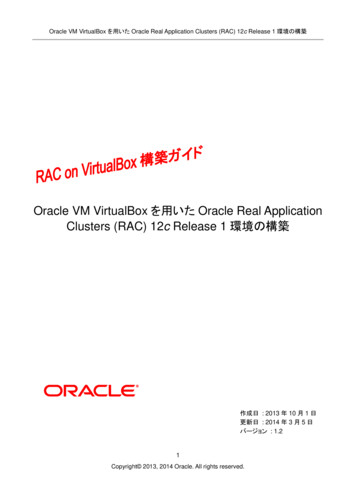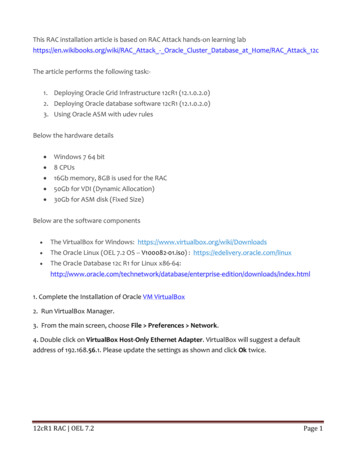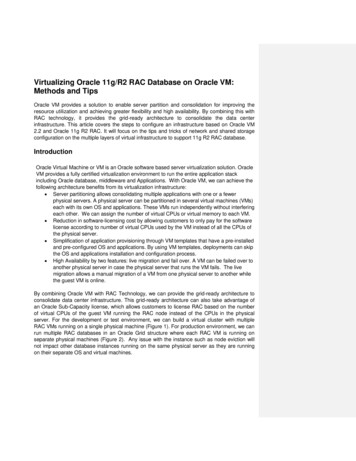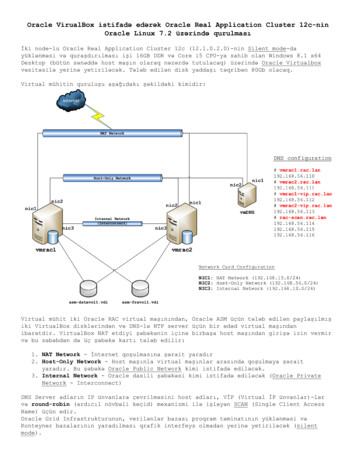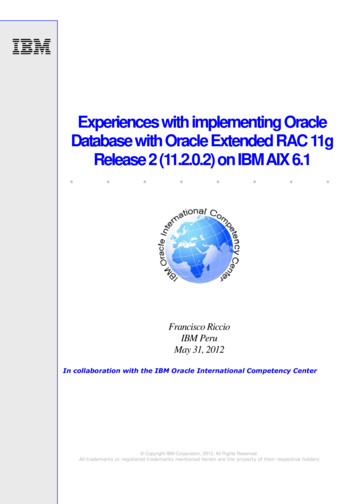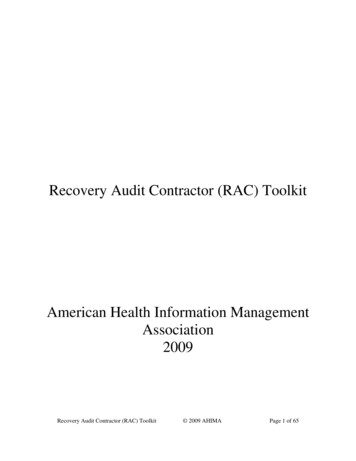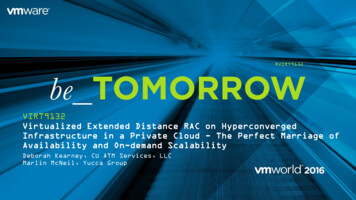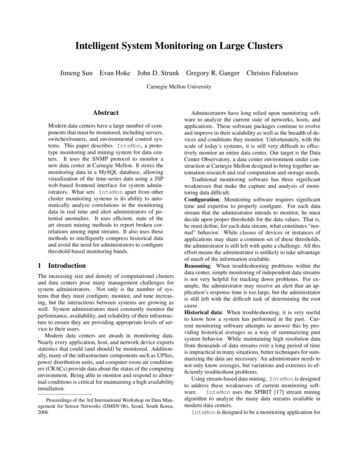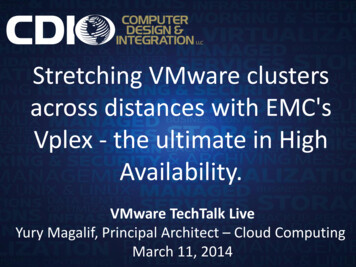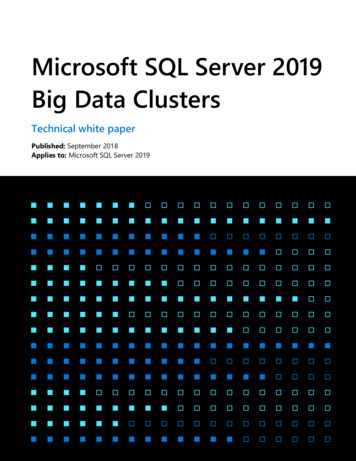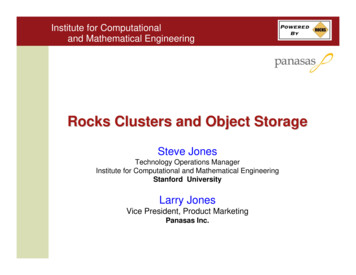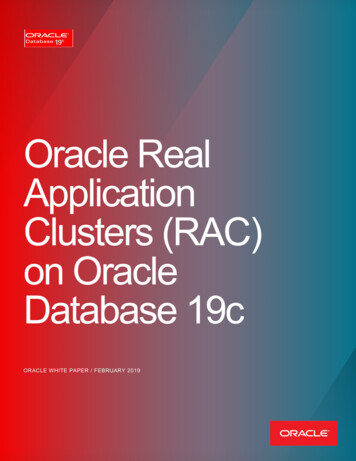
Transcription
Oracle RealApplicationClusters (RAC)on OracleDatabase 19cORACLE WHITE PAPER / FEBRUARY 2019
TABLE OF CONTENTSExecutive Overview. 3Overview of Oracle Real Application Clusters (RAC) . 4Oracle Clusterware. 4Oracle Automatic Storage Management . 6Better Scalability. 7Improved Algorithms. 7Scalable Sequences. 8Service Oriented Buffer Cache. 9Better Availability. 10Smart Reconfiguration . 10Recovery Buddy . 10Node Weighting. 10Continuous Application Availability . 11Efficient Management of a Pool of Clusters . 11Oracle Fleet Provisioning and Patching . 11Oracle Autonomous Health Framework . 11Conclusion . 122WHITE PAPER / Oracle Real Application Clusters on Oracle Database 19c
EXECUTIVE OVERVIEWOracle Real Application Clusters (RAC) is an option to the Oracle Database that provideshigh availability (HA) and scalability to the Oracle Database without requiring anyapplication changes. There is no other solution in the market that provides all the featuresas Oracle RAC.Enterprises today continue to generate more and more data at an unprecedented pace.Couple that with the need for corporations to rapidly analyze this growing data and identifytrends to react quickly to changing market conditions. The complexity of these challengesrequires increasing amount of computing power. Oracle RAC is perhaps the only solutionproviding linear horizontal scalability without application code change. In the latest release,Oracle RAC provides many new features and improvements to existing features, many ofwhich work autonomously below the covers without any need for manual intervention orcalibration.Oracle RAC customers also benefit from reduced CAPEX incurred during costly lift andreplace hardware cycles. Using Oracle RAC, new hardware can be provisioned along withold hardware, to create a pool of clusters running multiple instances of Oracle RAC. Allthese operations can be performed without incurring any downtime.Oracle RAC has evolved over the years from a database only option to a comprehensivestack that manages resources outside the database such as storage, network and CPU.Oracle RAC ships with Oracle RAC “Family of Solutions” which is an integrated suite ofproducts that help manage the entire stack from Oracle Database to the network, storageand operating system. This tight integration ensures that customers benefit from OracleRAC scalability and seamless failover regardless of deployment in public, private orhybrid cloud environments.Oracle RAC contributes immensely to the “autonomous” character of the OracleAutonomous Database. New features such as Autonomous Health Framework and existingfeatures such as Oracle Cache Fusion algorithms are continuously enhanced utilizing thelatest in hardware innovations and industry trends such as cloud computing and machinelearning. These features are discussed in detail in the technical section.3WHITE PAPER / Oracle Real Application Clusters on Oracle Database 19c
OVERVIEW OF ORACLE REAL APPLICATION CLUSTERS (RAC)Oracle Database with the Oracle Real Application Clusters (RAC) option allows multiple instances running ondifferent servers to access the same physical database stored on shared storage. The database spans multiplehardware systems and yet appears as a single unified database to the application. This enables the utilization ofcommodity hardware to reduce total cost of ownership and to provide a scalable computing environment thatsupports various application workloads. If additional computing capacity is needed, customers can add additionalnodes instead of replacing their existing servers. The only requirement is that servers in the cluster must run thesame operating system and the same version of Oracle. They do not have to be the same model or capacity. Thissaves on capital expenditures allowing customers to buy servers with latest hardware configurations and use italongside existing servers. This architecture also provides high availability as RAC instances running on differentnodes provides protection from a server failure. It is important to note that (almost) all applications such as OracleApplications, PeopleSoft, Siebel, SAP run without any changes on Oracle RAC.Customer’s requirement for database availability and scalability continue to increase as customers cannot affordany downtime in their environments anymore. These requirements are not isolated to just databases but includeother critical components such as servers, network, and client connections. Furthermore, there is a need for anintelligent resource manager that is able to redirect incoming workloads dynamically to nodes which are idle or insome cases more capable in terms of computing power and memory. The Oracle RAC family of solutionsprovides an integrated product bundle to ensure all these requirements are met. Oracle RAC family of solutions iscomprised of the following components.Figure 1. The Oracle RAC family of solutionsOracle ClusterwareOracle Clusterware is the technology that transforms a server farm into a cluster. Oracle Clusterware is acomplete, free-of-charge clustering solution that can be used with Oracle RAC, RAC One Node and even Singleinstance Oracle databases. Oracle Clusterware provides node membership, node fencing and optimal resourceplacement.NEW IN ORACLE CLUSTERWARE 19COracle Clusterware 19c enhances the new deployment options for easier management and deployments of largepool of clusters. The new architecture called Oracle Cluster Domain would enable individual clusters to dedicate4WHITE PAPER / Oracle Real Application Clusters on Oracle Database 19c
their resources to the database or application as management tasks such as deployment, storage management,performance monitoring is delegated to run on a pre-defined Cluster called the Domain Services Cluster.Figure 2. Oracle Cluster DomainAs shown in figure 2 above, a Cluster Domain consists of a single Domain Services Cluster (DSC) and one ormore Member Clusters. DSC provides many services which can be utilized by Member Clusters. There are fourtypes of member clusters1. Database Member Cluster with high performance local storage that is not shared with other Member Clusters.2. Application member cluster typically hosting applications.3. Database Member Cluster accessing ASM storage using the ASM I/O services provided by the DomainServices Cluster (DSC). This is also referred to as indirect access.4. Database Member Cluster accessing ASM storage on the Domain Services Cluster directly via SAN storage.This is also referred to as direct access.Regardless of the member cluster type, all of them benefit from the centralized Management Repository services,Trace File Analyzer services and other services provided by the DSC.CHOOSING A DEPLOYMENT MODEL.The choice of deployment no longer depends on the installation type as in previous releases. Oracle Clusterwarenow allows new installations to be deployed as a Cluster Domain model while allowing standalone Clusters to beconverted to Member Clusters. It is important to note that Oracle Clusterware licensing remains the same for bothdeployment models. Some aspects to consider when choosing a deployment model are: Cluster Domain architecture delegates the management aspects of Member Clusters to the DSC. Thisoptimizes the Member Cluster management in terms of both provisioning and performance management.Resources such as CPU and memory on the Member Cluster can now be dedicated to the database computingneeds resulting in cost savings for the customer.5WHITE PAPER / Oracle Real Application Clusters on Oracle Database 19c
Cluster Domain architecture provides a unified consolidated storage solution via the DSC. This model makes iteasier to provision new databases using the Oracle ASM cloning feature. Storage consolidation using theCluster Domain deployment model benefits vastly from the new Database oriented storage managementfeatures introduced in Oracle ASM. Centralized data collection facilities provided by Autonomous Health Framework (AHF) in the DSC allow theMember Clusters behavior to be analyzed using Machine learning capabilities used by AHF which continuouslymonitors the Member Clusters. This functionality can in many cases prevent a problem before it occurs. Forexample, AHF can detect anomalies between real time performance counters and expected values to notifysystem admin of impending performance issues while generating targeted diagnosis and corrective actions.For more information about Oracle Clusterware, visit oracle.com/goto/clusterwareOracle Automatic Storage ManagementOracle Automatic Storage Management (ASM) is the recommended volume manager that can be used for bothOracle RAC and single instance Oracle Databases. Oracle ASM simplifies storage management through theprinciple of stripe-and-mirror-everything (SAME). Intelligent mirroring capabilities allow administrators to define 2or 3-way mirrors to protect vital data. When a read operation identifies a corrupt block on a disk, Oracle ASMautomatically relocates the valid block from the mirrored copy to an uncorrupted portion of the disk.NEW IN ORACLE ASM 19Oracle ASM 19 enhances the database-oriented storage management introduced in previous releases via thenew ASM Flex Disk Group. Customers can now convert to the Flex Disk Group and take advantage of theenhanced management capabilities of Flex Disk Group such as (a) modifiable redundancy at individual databasefile level via File Groups, (b) Cloning/snapshot capabilities and (c) quota management at the database level forconsolidated environments. The ability to create snapshots on pluggable databases (PDBs) without relying on thesnapshot capabilities of the underlying storage enables DBAs to rapidly provision databases. ASM snapshots areexecuted at the database level without the need for downtime or any additional manual recovery steps.Additionally, modifiable redundancy allows database administrators to start with a conservative mirroring strategyand change the redundancy in future depending on business needs.Once the Disk Groups are converted to the new Flex Disk Group, storage administrators can utilize quotamanagement to set storage space limits at the database level which helps in consolidation environments as itprevents single database from utilizing all the space in the Flex Disk Group. For more information about OracleAutomatic Storage Management, visit oracle.com/goto/asmORACLE ASM CLUSTER FILE SYSTEM (ACFS)Oracle ACFS complements ASM file management capabilities by providing a POSIX-compatible file system tostore general purpose and database files. Oracle database has for a long time provided column types to storeblobs, XMLs and text files etc. However due to application or business requirements, customers needed a filesystem to store such data. Obviously storing this data outside the Oracle database requires customers tomanually plan for data management activities such as backup and synchronization across sites.ACFS provides a Cluster file system which customers can use to store this data. They can additionally use ACFSfeatures such as Tagging, Replication and Snapshots to ease their data management activities. New in 19c issupport for bidirectional snapshots and even better integration with Oracle Data Guard when using ACFS to storedata files. Customers can additionally utilize ACFS tagging feature to add custom tags to their data and retrievetags using a command line or using tagging API calls directly from their application. ACFS snapshots use copyon-write (COW) on generic systems without relying on specialized storage resulting in these snapshotsconsuming minimal space. For more information about Oracle ACFS, visit oracle.com/goto/acfs6WHITE PAPER / Oracle Real Application Clusters on Oracle Database 19c
BETTER SCALABILITYDatabase sizes have grown tremendously over the years and data volumes continue to grow at a very rapid pacewhile businesses require database to store transactions instantaneously and at the same time need fasterresponses to analytical queries. Oracle RAC help with these requirements. In fact, the scalability features inOracle RAC make it possible to start with a smaller footprint and scale out as needed resulting in massive savingsas customers do not need to provision a large environment upfront in anticipation of future requirements.Figure 3 below depicts the horizontal scale out of Oracle RAC running a SAP sales and distribution (SD) modulebenchmar
Oracle RAC has evolved over the years from a database only option to a comprehensive stack that manages resources outside the database such as storage, network and File Size: 1MBPage Count: 13
